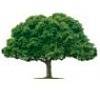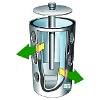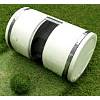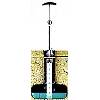Ways To Go Green

If you're looking for ways to go green then maybe window farming is an option. A window farm uses hydroponics to cultivate a vertical garden in your window.
These indoor window gardens can be designed from recycled materials and produce plants by subjecting the roots to nutrient-rich water solutions instead of soil.
You can grow nutritious fresh greens, fruits and vegetables such as kale, chard, lettuce, tomatoes, stevia, strawberries, squash, corn (and more) in any window like a year-round greenhouse.
The micro-climate of a window allows you to choose a wide variety of plants to cultivate. Different kinds of plants thrive in different climates.
A hot, dry, sun-drenched window may be better for cultivating certain types of fruits and vegetables while a cool, low-light, drafty window would be better suited for growing other kinds.
You can purchased window farm kits from a non-profit organization based in New York. According to Britta Riley of the Windowfarms Project, the organization's goal is to get as many people as possible to grow their own food using green technology.
Window farming is another option when you're looking for ways to go green.
Source: windowfarms.org
Solar Sensor
 Scientists at the University of Michigan have invented the world's smallest self-powered sensor. The sensor measures only 2.5 by 3.5 mm and is 1000 times smaller than comparable commercial sensors.
Scientists at the University of Michigan have invented the world's smallest self-powered sensor. The sensor measures only 2.5 by 3.5 mm and is 1000 times smaller than comparable commercial sensors.
It combines a processor, solar cells and a battery and operates almost perpetually by harvesting energy from light, movement or heat.
The invention vastly improves the efficiency and cost of sensors currently used to monitor and track environmental changes.
Source: ns.umich.edu; photo: Daeyeon Kim
Solar Ink
Konarka Technologies of New Bedford, Massachusetts have discovered new ways to generate electricity by using photo-reactive polymer ink.
This new technology is the result of combining inkjet printing with organic flexible photovoltaics.
 The proprietary ink can be printed inexpensively similar to roll-to-roll manufacturing used for printing newspapers.
The proprietary ink can be printed inexpensively similar to roll-to-roll manufacturing used for printing newspapers.
The solar sheets can absorb light and generate electricity that can be plugged into a grid or used for recharging products.
A photo-reactive printed layer, a transparent electrode layer, a substrate and a protective packaging layer are combined to make a thin sheet.
The company holds over 350 patents for the material and processes it uses. The technology was invented by Konarka co-founder Alan Heeger, who was awarded a Nobel Prize in 2000 for chemistry.
Source: konarka.com
Planet Green Concrete
The cement industry creates approximately 5% of the earth's carbon emissions, which is more the entire aviation industry.
Around 2 billion tonnes of cement is used each year with each tonne creating .4 tonnes of carbon dioxide.
 The industry is trying to find ways to go green to reduce carbon emissions, so scientists at Sheffield Hallam University developed an eco-friendly alternative to cement made from mostly recycled inorganic powder.
The industry is trying to find ways to go green to reduce carbon emissions, so scientists at Sheffield Hallam University developed an eco-friendly alternative to cement made from mostly recycled inorganic powder.
The new material is easier to use in construction and resists temperatures in excess of 1100 degrees Celsius unlike concrete that explodes when exposed to extreme heat.
Thirty-percent less material is required to make precast blocks compared to cement.
"It replaces most of the cement used in standard concrete. I believe it has great potential for the future," says inventor Professor Pal Mangat of Shellfied Hallam University.
The new granite-like material is being used in a number of building projects dedicated to finding ways to go green, which includes the Olympic Village in London.
Source: liquidgranite.co.uk

|
| Solar tree collects energy better than solar panels. |

|
| World's best organic cooler. |







